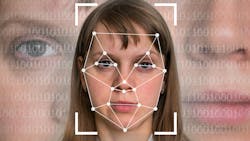Using Facial Recognition Technology in Law Enforcement
Law enforcement often balances public safety and individual privacy with technology. The increased use of technology, like facial recognition, puts police in the crosshairs of politicians, the media, and community transparency groups. Law enforcement must use current technology to keep up with criminals who willingly embrace new technologies.
As with any investigatory strategy, facial recognition is not the definitive answer to solving the case. However, the technology can and should be used to generate leads. Often, a good lead is all that an investigator needs to solve the case.
What is Facial Recognition?
Facial recognition uses machine learning algorithms (where the machine learns what to do from matches and how to improve searches through incorrect results) to look for matches to a photo from within a set database. The search uses data points in the image to find matches. Poor lighting of the image being searched, the addition of glasses, a face mask, a hat, or other items can impede system recognition. Shadowing or a side angle of the face, rather than a front view, can also negatively impact a match. Facial recognition is also affected by human aging; changes in facial features from weight gain or loss or cosmetic surgery can also challenge facial recognition.
Law enforcement most frequently uses facial recognition through vendor software that is available commercially. The vendor holds the images, often pulled from social media, and uses those images and their associated data points to search through during a query by law enforcement. More recently, some policing agencies have started using software applications to search private databases, like driver’s licenses and booking photos.
Security and Policing Uses of Facial Recognition
Facial recognition technology has grown exponentially in the last several years. Before 2018, Federal law enforcement used facial recognition sparingly. A GAO report found that, as of 2023, seven law enforcement agencies in the Department of Homeland Security and Department of Justice use commercial and nonprofit facial recognition services.
The GAO report did not consider the Transportation Security Administration (TSA), yet TSA has tested facial recognition in several situations. Harry Reid International Airport in Las Vegas, Nevada, recently introduced passenger self-screening security lanes. These lanes demonstrate the abilities of current technology in security screening, which includes using video analytics as part of the “Screening at Speed” program to verify passenger identity.
Current Applications
- In January 2024, an arrest was made in the January 2021 capitol incident using facial recognition. The suspect was located by matching incident photos to social media posts from a personal Facebook account, which led to the arrest.
- A news report out of Colorado states that police agencies, both local and federal, are using the Colorado DMV facial recognition program to find investigative leads. The report found that the use of DMV photos for facial recognition by law enforcement started at 42 uses in fiscal year 2012-2020 and was up to 157 uses last fiscal year. The news report also pointed out that using facial recognition is only to obtain possible leads, not probable cause for arrest, nor is it enough to get a search warrant.
- Some international agencies also use facial recognition to prevent and prosecute retail theft. The same facial recognition software, available commercially, is also being used by some stores in the UK to prevent future theft. In the US, the NYC mayor has encouraged retail stores to employ facial recognition to deter and prosecute shoplifting and theft. In a different use case, Madison Square Garden uses facial recognition scanning through a vendor to identify attorneys in litigation with the venue.
Privacy and Political Concerns
Last week, the Government Accountability Office (GAO) released an update on facial recognition, reiterating the need for staff training and other recommendations for agencies using facial recognition. In addition to training requirements, the GAO recommends addressing privacy requirements and concerns and implementing policies on facial recognition to aid in transparency and acknowledge civil rights concerns. The Bureau of Justice Assistance released a policy template in 2017 specifically for facial recognition use in intelligence and investigative actions. That template includes addressing privacy concerns in the agency’s policy.
Politicians, especially in election years, often look at technologies that may seem invasive to some citizens. Some states have weighed in on law enforcement's use of facial recognition, and there are laws, such as the one in Colorado, stating that the results of a facial recognition search may only be used as an investigative lead. Now, Congress is looking at federal agencies' use of facial recognition. Whether additional laws will be enacted governing the use of facial recognition is unknown; each agency using this technology should know the laws that impact their searches.
Identifying Suspects
Facial recognition technology continues to improve, and case law and new laws are being enacted to influence how law enforcement uses this tool. Facial recognition can help investigators obtain a lead more quickly in certain situations. Just as policing has relied on eyewitness identification of suspects, facial recognition through machine learning offers the same.
In today’s world, surveillance is expected. Many public jurisdictions, private companies, and even private households have cameras that record activity. Facial recognition technology will only continue to improve through continued use. With more photos to search being added to databases regularly, the ability to find possible matches continues to improve. Law enforcement will continue embracing technology tools like facial recognition to bolster existing investigation processes. Agencies that lean on these tools to augment staff efforts should also include policies and training to help protect not only the agency but also their staff and provide transparency to the community.
About the Author
Toni Rogers
Toni Rogers is a freelance writer and former manager of police support services, including communications, records, property and evidence, database and systems management, and building technology. She has a master’s degree in Criminal Justice with certification in Law Enforcement Administration and a master's degree in Digital Audience Strategies.
During her 18-year tenure in law enforcement, Toni was a certified Emergency Number Professional (ENP), earned a Law Enforcement Inspections and Auditing Certification, was certified as a Spillman Application Administrator (database and systems management for computer-aided dispatch and records management), and a certified communications training officer.
Toni now provides content marketing and writing through her company, Eclectic Pearls, LLC.

